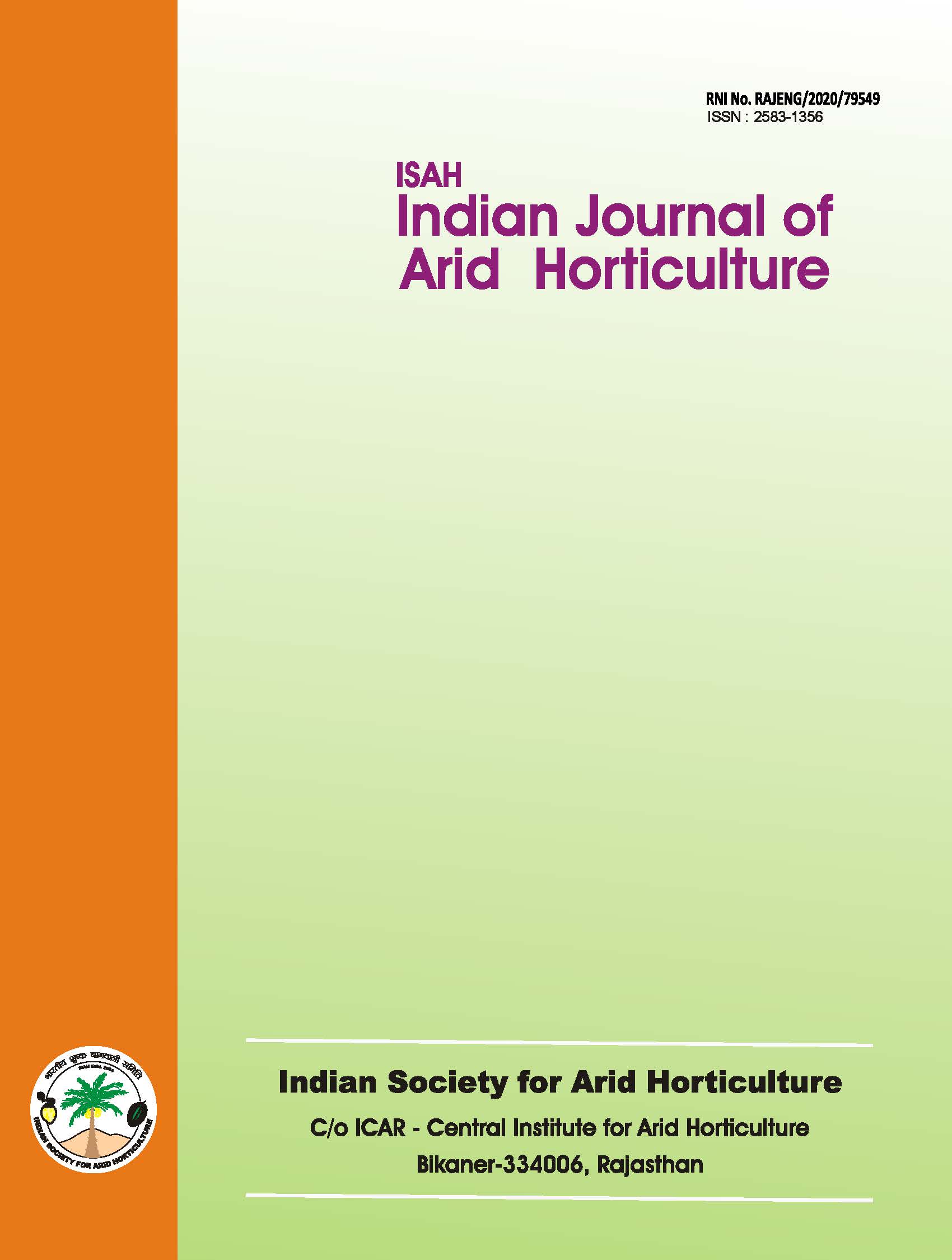Studies on maturity indices of karonda (Carissa carandas L.) fruits
Keywords:
Subtropical, Apocynaceae, vernacular, flourish, salineAbstract
Karonda (Carissa carandas L.) a member of family Apocynaceae is an indigenous fruit of Indian subcontinent. It is an underutilized evergreen thorny bush which thrives well through out Tropical and Subtropical climate (Singh and Singh, 1992) and is also found in Africa, Australia, Srilanka, Thailand, Indonesia and Malaysia mainly in wild form. In India its cultivation was initiated by the European in Kitchen garden to get fruit for jelly preparation. Karonda is known by several vernacular names such as karaunda, Karunda, garinga, krrona, timukhia and gotho in Hindi; Kurumia, Karamcha, Bainchi, Karenja and tair in Bingali; Karauanda and baronda in Marathi; Karamarda and Timbarran in Gujrati; Karamarda, Karamardaka, avinga and vrishnapakphula in Sanskrit; Kendakeri and Kerendokuli in Uriya; waaka and kalivikaya in Telgu and Kalaka and Kalapa in Tamil. It can flourish well on saline, alkaline and other waste lands on which other fruit crops do not thrives well. Karonda is best plant for live fencing that also produces fruits.Downloads
References
Akamine, E.K. and Goo, T. 1971. Relationship between surface colour development and soluble solids in papaya. Hort. Sci. 6(6):567-568.
Ashraf, S.M. 1987. Studies on Post Harvest Technology of Jamun fruits.Ph.D.Thesis, N.D.University of Agriculture and Technology, Faizabad, U.P., India.
Daulta, B.S. and Gupta, U.S. 1973. Determination of maturity standards in some grape cvs. under Hissar conditions.Haryana J.Hort.Sci. 2 (3):23- 24.
Hawker, J.S. 1968. Enzymes involved in sugar metabolism in the developing grape varietieis. Proce.Aust.Biochem. Soc.12 mtg. 126:66.
Pandey, R.C., Pathak, R.A. and Pathak, R.K. 1990. Physico chemical changes associated with growth and development of fruit in ber (Zizyphus mauritiana Lamk.). Indian J.Hort, 47 (3):286-290. Paralkar, P.S., Joshi, G.D. and Saivi, M.J. 1987. Studies on physico-chemical changes in sapota cv.Kalipatti fruits during growth and development. Indian Fd. Packer. 41(4):11-18.
Ranganna, S. 1978. Manual of Analysis of Fruit & Vegetable Products. Tata Pub. Co. Ltd., New
Delhi.
Singh, A. and Abidi, A.B. 1986. Studies on physico- chemical attributes of some promising Litchi cvs.during ripening.Narendra Deva J.Agric. Res. 1:70-73.
Singh, I.S., Pathak, R.K., Diwedi, R. and Singh, H.K. 1993. Aonla Production and Post harvest Technology. Bulletin, Department of Horticulture, N.D.University of Agriculture and Technology, Faizabad, U.P., India.
Singh, J.R. and Singh, A.K. 1992. Indian Pomology,
Kaushilya Prakashan. Varanasi (India).
Singh, V.R., Pandey, I.C., Upadhyay, W.P. and Tripathi, B.M. 1976. Physiological and biochemical changes during maturity of mango variety Neelam. Prog.Hort. 8:13-18.
Vasu, N. 1986. B.R.Publication Corporation, Delhi.
Encyclopaedia Indica. Vol. IV.
Watt, G. 1972. A dictionary of the economic product of
India. Vol.II, Cosmo Publications, New Delhi. Wilson, R.F. 1938. Horticultural Colour Chart. Wilson colour Ltd. (In collaboration with the Royal Horticultural Society and British Colour Council) Londan.

